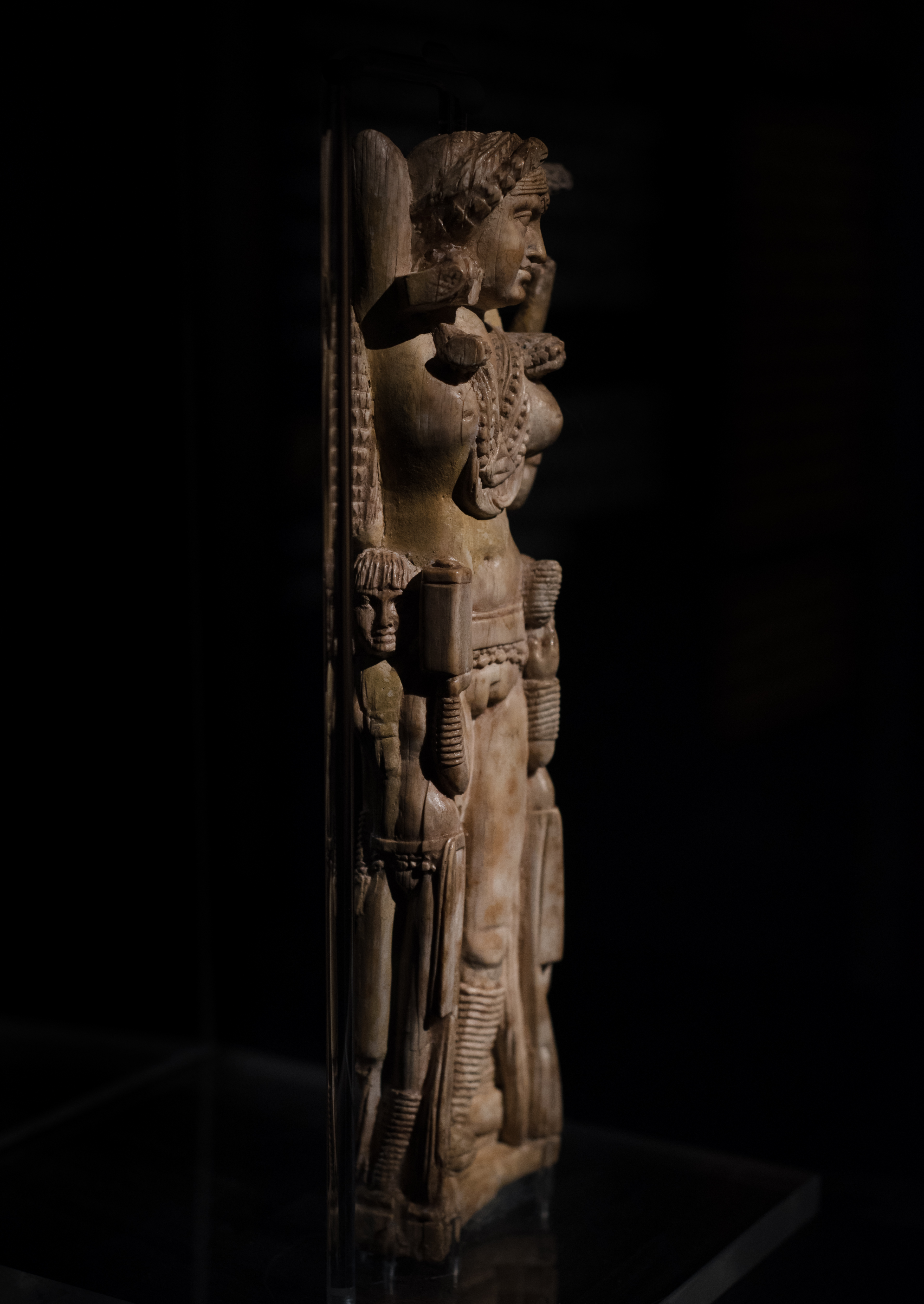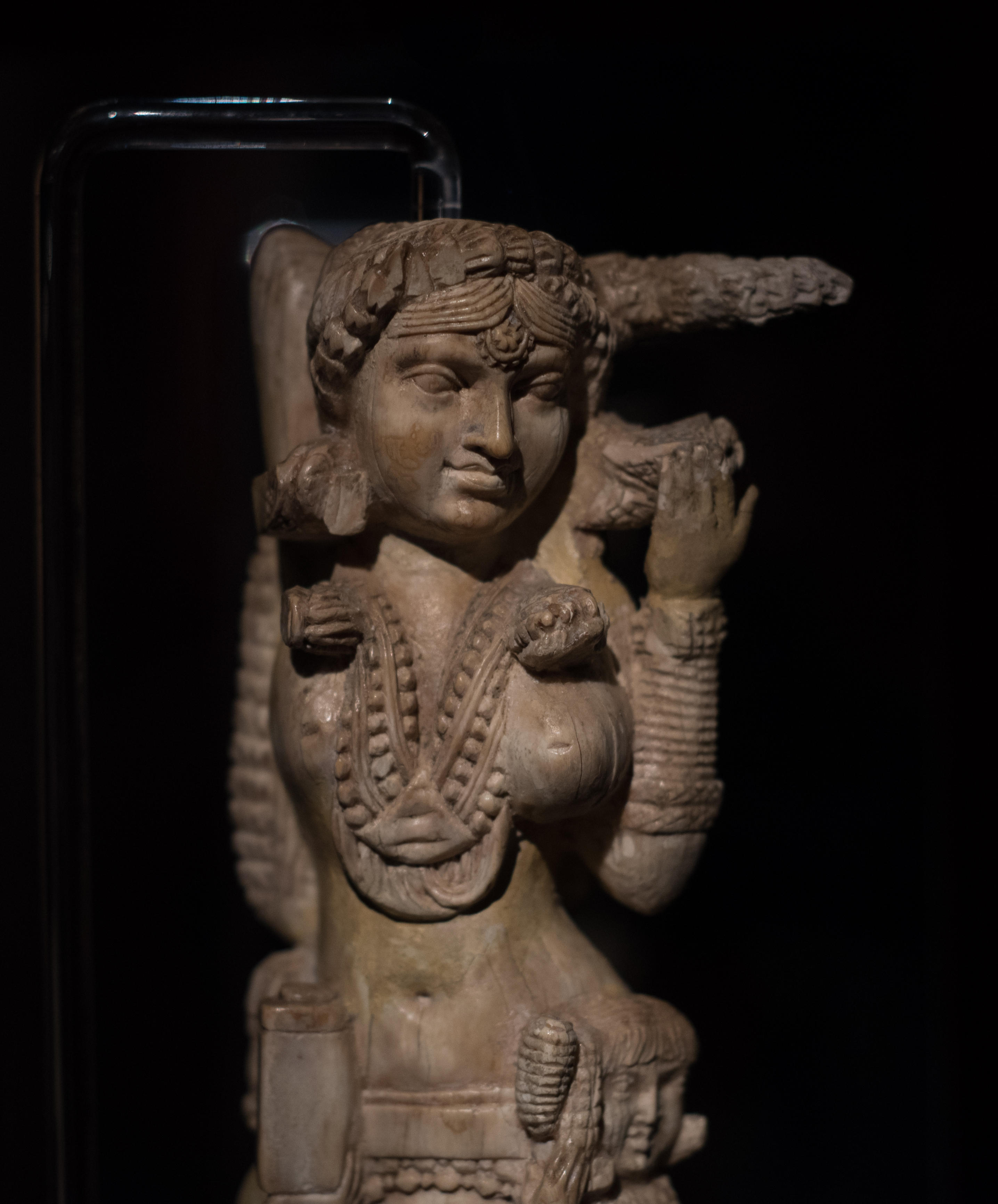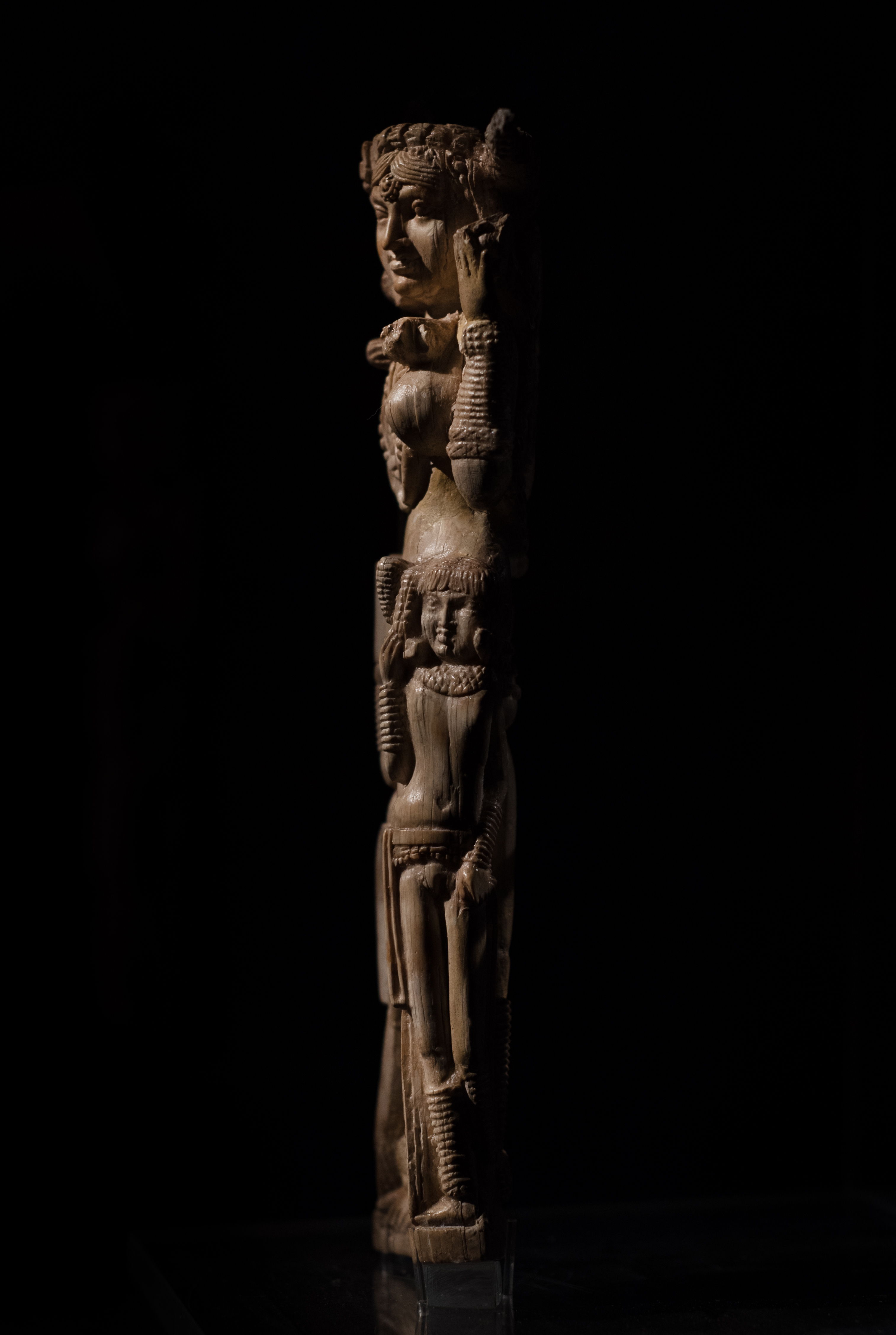(SESSION 1) “COMPARANDA AS CONTEXT?” - THE POMPEII FIGURINE AND INDIAN YAKSHIS
This session discusses Indian comparisons and meanings for the Pompeii object. Lead speakers: Chandreyi Basu (St. Lawrence University) and Pia Brancaccio (Drexel University).


The Pompeii figure (fig. 1), unearthed in 1938, has long been considered an emblem of Indo-Roman trade and cultural interactions. Since coming to light, the figure has attracted multiple theories about her identity —‘Indian Venus’, ‘Pompeii Lakshmi’, or more factually, ‘Indian statuette in Pompeii’—and her origins. Does she hark from a northwestern Indian tradition tied to Begram, Ter and Bhokardan, or a more central Indian tradition around Sanchi and Mathura? In her Pompeiian context, was the figure understood as a deity and a natural representation of a woman, or an over-sexualized piece of exotica? These are the questions we will wrestle with in this session.
The figure was uncovered at Pompeii in 1938 by Italian archaeologist Amedeo Maiuri. It was found in fragments in the garden of House I.8.5 on the Via dell’Abbondanza, known as the ‘House of the Indian Statuette’ ever since, in a cache of other craft goods. It would have been buried with the rest of the city by the eruption of Vesuvius in 79 CE, indicating that it must have arrived in Pompeii by the first half of the 1st Century CE.
On discovering the figure, Maiuri proclaimed she was ‘Indian Venus’ and described her ‘harsh raw sexuality’ (indeed, even today the figure is displayed beside a Venus in Bikini (fig. 4)). He then claimed she was the Hindu goddess Lakshmi because of similarities to iconography at Sanchi in Madhya Pradesh, India—especially a carving of Lakshmi with lotuses (fig 5) attended by two miniature figures at Stupa no.2 . Maiuri’s claims are supported by Mirella D’Ancona, writing a decade later. Scholarship on the Pompeii figure did not shift until the turn of the century, which brought increased interest from scholars in South Asian studies and new interpretations on its origins. The dominant theory now, posited by Chandreyi Basu and Sanjyot Mehendale, is that the figure originated from a northwestern Indian tradition, due to its material and iconographic similarities to ivory female figures from Begram (figs. 7 and 8) (in modern-day Afghanistan), Ter (fig. 9) and Bhokardan (fig. 10) (both in Maharashtra, western India). It is also with these scholars that we find a new theory on the figure’s identity: that she is a yakshi (a nature spirit often found in Hindu-Buddhist-Jain iconography), not the goddess Lakshmi—a view which prevails to this day.
Since it was uncovered, the figure has been located just a few miles away from its find-spot in the Gabinetto Segreto of the Museo Archeologico Nazionale di Napoli, where it can still be seen today alongside the aforementioned Venus in Bikini and several phallic wall paintings and objects.The figure was for a long time named the Pompeii Lakshmi, maintained by the museum until 2021, when finally it changed the description label to “Ivory statuette representing an Indian goddess.”
Object Video
Speaker bios
Chandreyi Basu specializes in the art of early northwest India and teaches Art History at the undergraduate level at St. Lawrence University, USA. Her Ph.D. dissertation (University of Pennsylvania, 2001) and recent publications focus on patronage and iconography of Mathura sculptures. She has also written about the representation of urban culture in Gandhāran narrative reliefs, the Indian ivory figurine found in Pompeii, female ascetics, and body markings. Her current research examines visual representations of animal-human interactions in early India.
Pia Brancaccio is Professor of Art History at Drexel University in Philadelphia, USA. She completed her Ph.D. in South Asian Art and Archaeology at the Universita’ degli Studi di Napoli l’Orientale in Italy, and is a longtime collaborator of the Italian Archaeological Mission in Pakistan. Her research focuses on early Buddhist art and cross-cultural exchange in South Asia, with a special focus on the ancient regions of Gandhara and the Western Deccan. Her publications include the volumes The Buddhist Caves at Aurangabad: Transformations in Art and Religion (Brill Publishers, 2010); Living Rock: Buddhist, Hindu and Jain Cave Temples in Western Deccan (Marg, 2013), and Gandharan Buddhism: Archaeology, Art and Text co-edited with Kurt Behrendt (UBC Press, 2006), in addition to numerous articles in festschriften, conference proceedings and academic journals (Ars Orientalis, Archives of Asian Art, East and West, South Asian Studies, Hualin International Journal of Buddhist Studies).
Images
The Pompeii Figure (fig. 1)
Comparanda
- Venus in Bikini (fig. 4)
- Figures from Sanchi: Lakshmi with lotuses (fig. 5) and Yakshi from East Gate (fig. 6)
- Begram figures (figs. 7 and 8)
- Ter figurine (fig. 9)
- Bhokardan statuette fragment (fig. 10)
Context
Discussion Questions
-
Does the Pompeii figure resemble images of Aphrodite? How and how not? What other sorts of figures does this object resemble?
-
Was there possibly an Aphrodite-Lakshmi cult or iconographic type?
-
If this is not an Aphrodite-Lakshmi, is this a yakshi? Why or why not? Does the concept of a yakshi as salabhanjika (woman intertwined with a tree) have any meaning in the ancient Roman world?
-
Would a Roman have viewed the figure as a representation of a meretrix (prostitute) given its representation? Or would they have compared it to a representation of a deity?
-
Would a Roman have perceived the figure as an art object or cultic object? Or is such distinction a projection of our modern distinction between the artistic and cultic object?
-
How was the material ivory understood at its point of manufacture? As a trade good? As a finished object where it was received? What meanings were associated with the materials?
-
How familiar would common Pompeiians have been with the myths and texts describing ivory objects? Would these stories have instantly jumped to mind when seeing the figure? Wouldn’t its unusual form, unusual representation of nudity ,and the preciousness of ivory have jumped to attention first, before these loosely connected myths?
-
What was traded along maritime routes? How do plants and plant-materials play a role in Indian Ocean trade? How can we contextualize this figurine within a market context prioritizing exotic raw materials?
-
What can we say about how this find relates to the port of Puteoli?
-
What can be said about the absence of similar objects in Italy: why are there not more Indian figurines in Italy?
-
How does the methodology applied to the study of the Pompeii figure influence and affect the study of other Indian figures found within extra-Indian territories?
-
How has seeing this object in a museum affected interpretations?
Key References
Basu, Chandreyi. “The Heavily Ornamented Female Figure from Pompeii.” In Il Fascino Dell’Oriente Nelle Collezioni e Nei Musei d’Italia, edited by Beatrice Palma Venetucci. Frascati (Roma), 2010. 59–63.
Brancaccio, Pia. “Looking to the West: Stone Molds and Foreign Visual Models in Satavahana Material Culture (First–Second Century Ce).” Archives of Asian Art 64, no. 1, 2014. 33–41.
D’Ancona, Mirella Levi. “An Indian Statuette from Pompeii.” Artibus Asiae 13, no. 3, 1950. 166–80.
During Caspers, Elisabeth CL. “The Indian Ivory Figurine from Pompeii–a Reconsideration of Its Functional Use.” South Asian Archaeology, 1979. 341–53.
Ferrari, Ivan. “La Statuetta Indiana Da Pompei: Nuove Considerazioni per Un Approccio Emico.” LANX. Rivista Della Scuola Di Specializzazione in Archeologia-Università Degli Studi Di Milano, no. 24, 2016. 112–30.
Maiuri, Amedeo. “Statuetta Eburnea Di Arte Indiana a Pompei.” Bollettino d’Arte, anno I. 1939. 111-15.
Mehendale, Sanjyot. “The Ivory Statuette from Bhokardan and Its Connection to the Ivory Statuettes from Pompeii and Ter.” In South Asian Archaeology 1991: Proceedings of the Eleventh International Conference of the Association of South Asian Archaeologists in Western Europe, edited by Adalbert J. Gail and Gerd J.R. Mevisson. Stuttgart: Franz Steiner Verlag, 1993. 529–38.
———. Mehendale, Sanjyot. “The Begram Ivory and Bone Carvings: Some Observations on Provenance and Chronology.” Topoi. Orient-Occident 11, no. 1, 2001. 485–514.
Parker, Grant. “Ex Oriente Luxuria: Indian Commodities and Roman Experience.” Journal of the Economic and Social History of the Orient 45, no. 1, 2002. 40–95.
Weinstein, Laura R. “The Indian Figurine from Pompeii as an Emblem of East-West Trade in the Early Roman Imperial Era.” In Globalization and Transculturality from Antiquity to the Pre-Modern World, edited by Serena Autiero and Matthew Adam Cobb, 2022.
Additional reading:
Agrawala, R. C. “Early Indian Bone Figures in the National Museum, New Delhi.” East and West 18, no. 3/4, 1968. 311–14.
Brancaccio, Pia. “Sātavāhana Terracottas: Connections with the Hellenistic Tradition.” East and West 55, no. 1–4, 2005. 55–69.
Carver, Kimberly. “Goddess of the Garden: Evidence of Everyday Life and Worship in the Gardens of Pompeii,” 2014.
Kaur, Raminder. “‘Ancient Cosmopolitanism’ and the South Asian Diaspora.” South Asian Diaspora 3, no. 2, 2011. 197–213.
Mehendale, Sanjyot. “Begram: Along Ancient Central Asian and Indian Trade Routes.” Cahiers d’Asie Centrale, no. 1/2, 1996. 47–64.
———. Begram: New Perspectives on the Ivory and Bone Carvings. University of California, Berkeley, 1997.
Parker, Grant. The Making of Roman India. Cambridge UP, 2008.
Taddei, Maurizio. Excavations at Bhokardan (Bhogavardhana), 1973. JSTOR, 1976.
Handout produced by Ivan Ferrari (Università degli Studi di Trento): Ovid, Metamorphoseon libri, liber X
-----------------------
To return to the main page click here.
